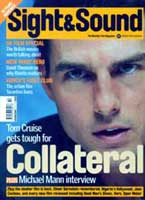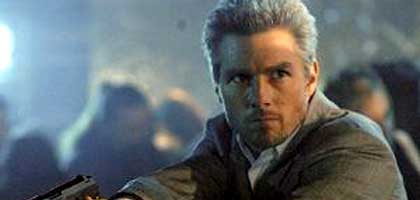
It Happened One Night

Michael Mann's Collateral is an intense return to the crime genre that made his name, with a rare villainous role for Tom Cruise, moody night-time photography and set-piece shootouts to rival those in Heat. Mark Olsen introduces the film and talks to Mann about his love of LA, shooting on DV and getting what he wants.
Collateral is pure pulp - a hitman ensnares a hapless cabbie into acting as his de facto chauffeur for an evening of murder and mayhem - but in the hands of high-style film-maker Michael Mann it becomes something richer and classier. Working from a script by Stuart Beattie to which he made extensive revisions and shooting mostly on high-definition digital video cameras (the Thomson Grass Valley Viper FilmStream and the Sony CineAlta) modified to his specifications following five months of intensive pre-production work, Mann takes the viewer on a nocturnal tour of Los Angeles quite unlike any other.
In Mann's portrait of the megalopolis, the beaches, bikinis and eternal sunshine of celluloid California are replaced by a tenuously interconnected set of zones containing black neighbourhoods, Korean nightclubs and Latino gangsters. Our journey back and forth across the city is so well mapped - with the glass spires of downtown providing a point of orientation - that no matter how incredible the plotting, one's sense of location is always spot on. Taking the trip are Tom Cruise as the hitman Vincent and Jamie Foxx as his reluctant accomplice Max. They have a busy night ahead of them: dressed in a designer suit, with steel-grey hair and neatly clipped stubble, Vincent is working his way through a list of five protagonists in an upcoming criminal case against one of his clients; quiet, hardworking Max, who's been dreaming for years of starting an upmarket chauffeur business, must tap into resources he probably never knew he had.
The film opens with Max picking up female fare Annie (Jada Pinkett Smith), and after a playful squabble over the best route from the airport to downtown the two settle into a mutually enjoyable conversation in which they let down their guard. Vincent, glimpsed moving through the airport terminal in the opening shot, materialises downtown, passing Annie on an escalator before hopping into the cab. Already Mann has introduced some of the themes that wend their way through his oeuvre, such as the way people define themselves by their work and a fascination with process, joined here by an examination of the way fate and coincidence intertwine to form a noose that will bind the three characters ever tighter. The final reel may tip into unwelcome melodrama, but with a performance of murderous charm by Cruise (whose sparring with Foxx early on in the movie has a screwball bite and fizz), a fantastically moody after-hours stop-off in an empty jazz club, and a furious, beautifully choreographed shootout in a crowded nightclub - perhaps the finest action set-piece Mann has staged since the street battle in Heat (1995) - the build-up is superb.
Mann's previous feature Ali (2001, in which Foxx played the boxer's motivator Drew Bundini Brown) was weighed down by the moody introspection the director overlaid on the saga of Muhammad Ali's years of triumph. Which makes the lighter tone of Collateral more of a surprise, as Mann returns to the familiar territory of the existential crime drama explored using new techniques and ideas. Probably the first studio director to embrace digital for its purely aesthetic potential, Mann uses the high-definition technology - in particular its ability to register a rich array of colours and tones in low light and at night - to realise his vision of the city. If the LA of Heat was crisp, almost photorealist in its high-gloss intensity, here the night-time cityscape is rendered with a watercolour delicacy. Collateral's after-hours timescale may be classic noir, but Mann's subtle night-vision - the dark sky seems bathed in an urban glow (the pale wash of orange street lights, streaks of white automobile headlights) - softens the genre's chiaroscuro tendencies.
Mann first experimented with digital cameras in the opening of Ali, capturing clouds moving against a night sky. He subsequently produced a short-lived television show called Robbery Homicide Division that was shot with high-def cameras partly for the sake of economy and partly to enable the film-makers to work in extremely low light levels. At the time the show seemed an extension of Heat, but it can now be seen, as Mann points out, as a "rehearsal" for Collateral.
Visually Collateral also resembles the spirited first hour of Kubrick's Eyes Wide Shut (1999), another Tom Cruise mood piece. The two films share an abundance of lighting sourced on screen and a palette of hazy blues and greens mixed with smeary oranges, reds and yellows. If Kubrick could prefigure the colours and framing of the still-emerging digital aesthetic, Mann is perhaps the perfect film-maker to take the technology forward.
In conversation Mann's voice retains the low honk of his Great Lakes upbringing. Even in an all-too-brief telephone call, a question about the geography of Los Angeles yields a response that takes in the history of immigration patterns in Chicago, and a stream of figures, percentages and ratios pours forth without hesitation. It's perhaps unsurprising that a film-maker renowned for his attention to detail should be drawn to the knob-twiddling precision of high-end digital video. And as Mann insists: "I'm interested only in doing what I want."
